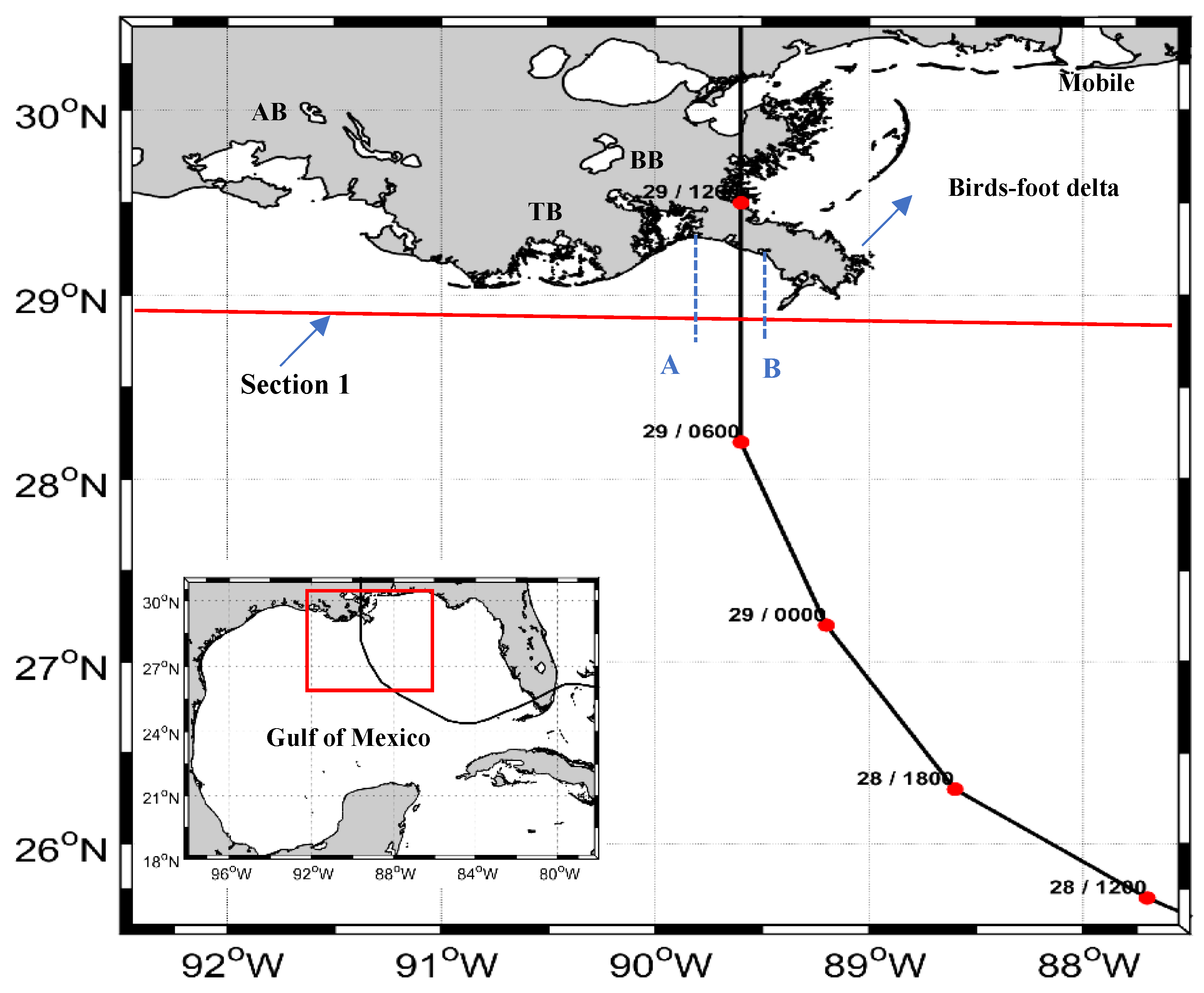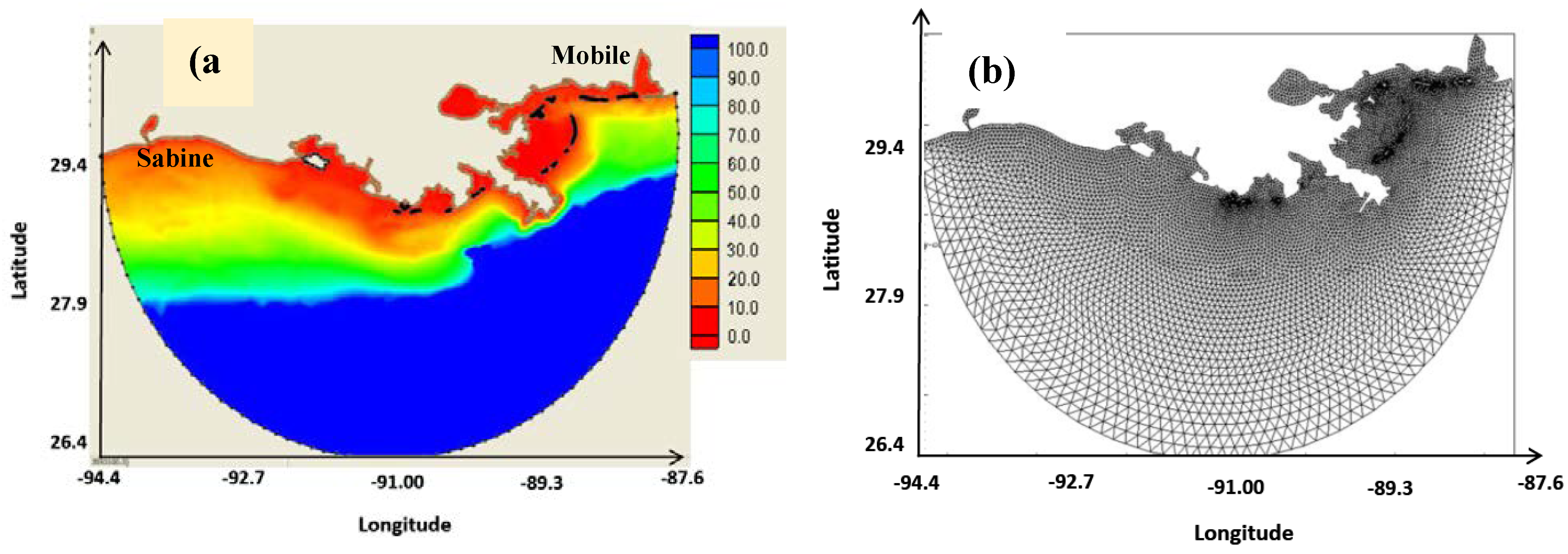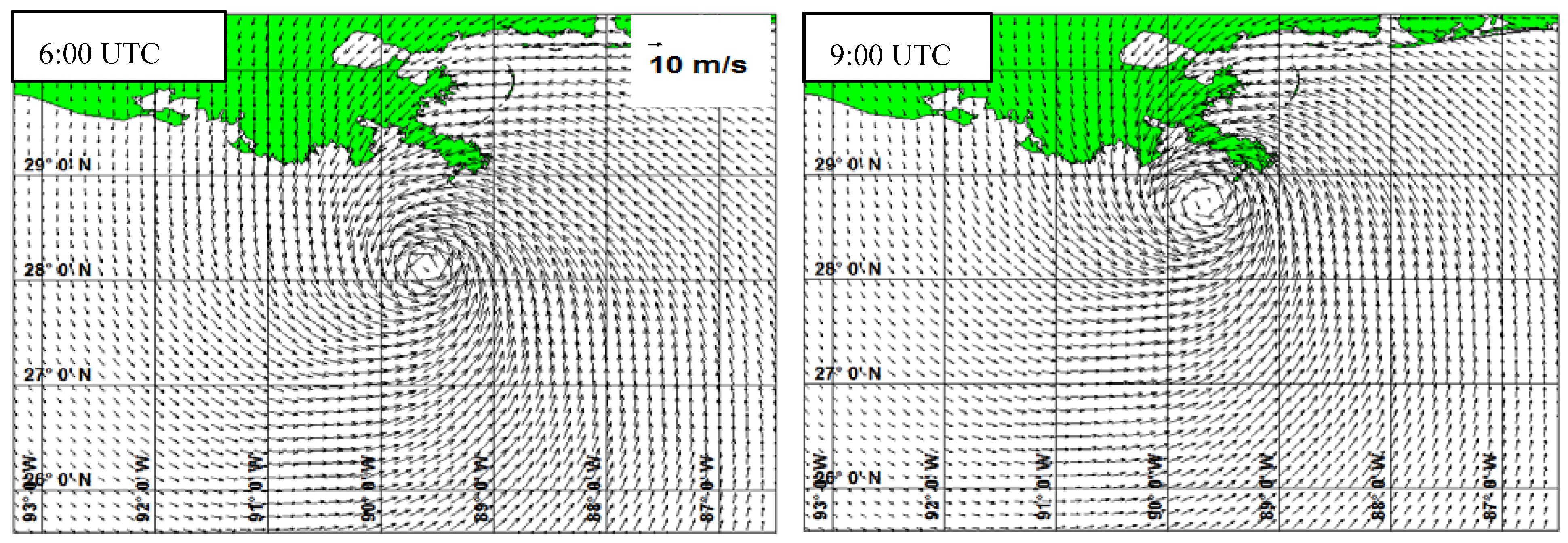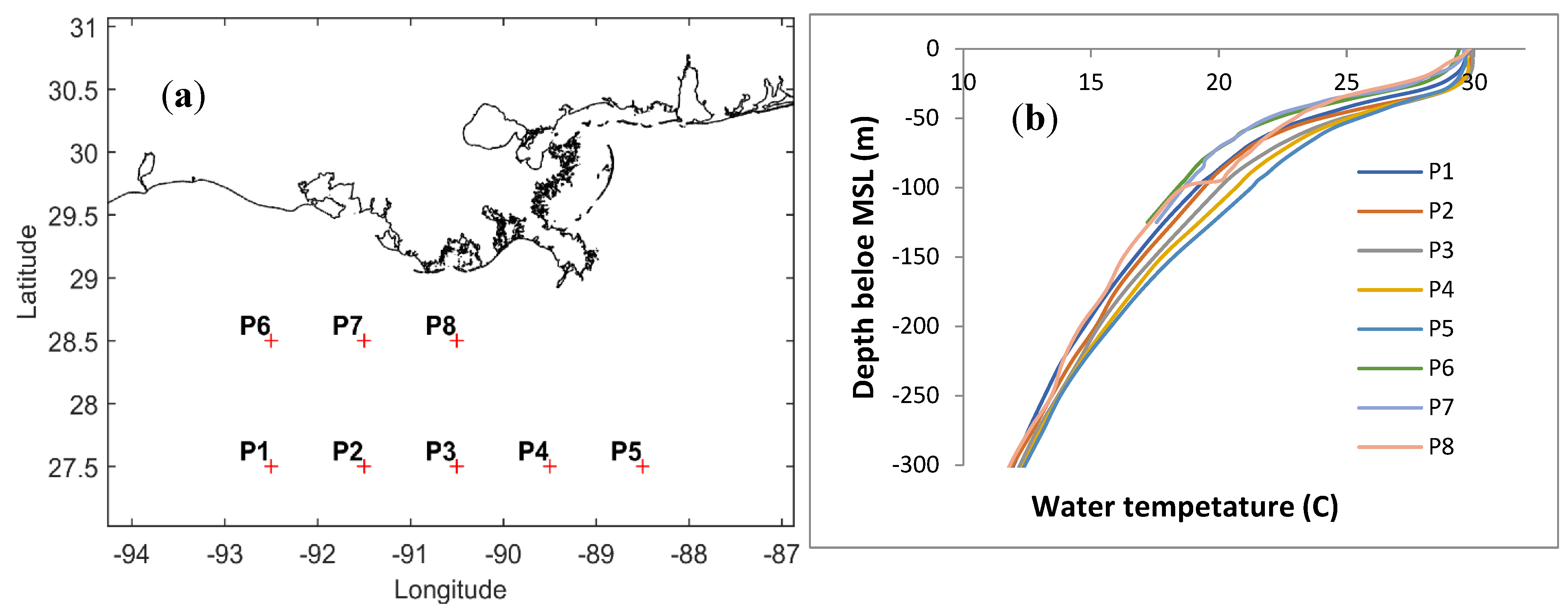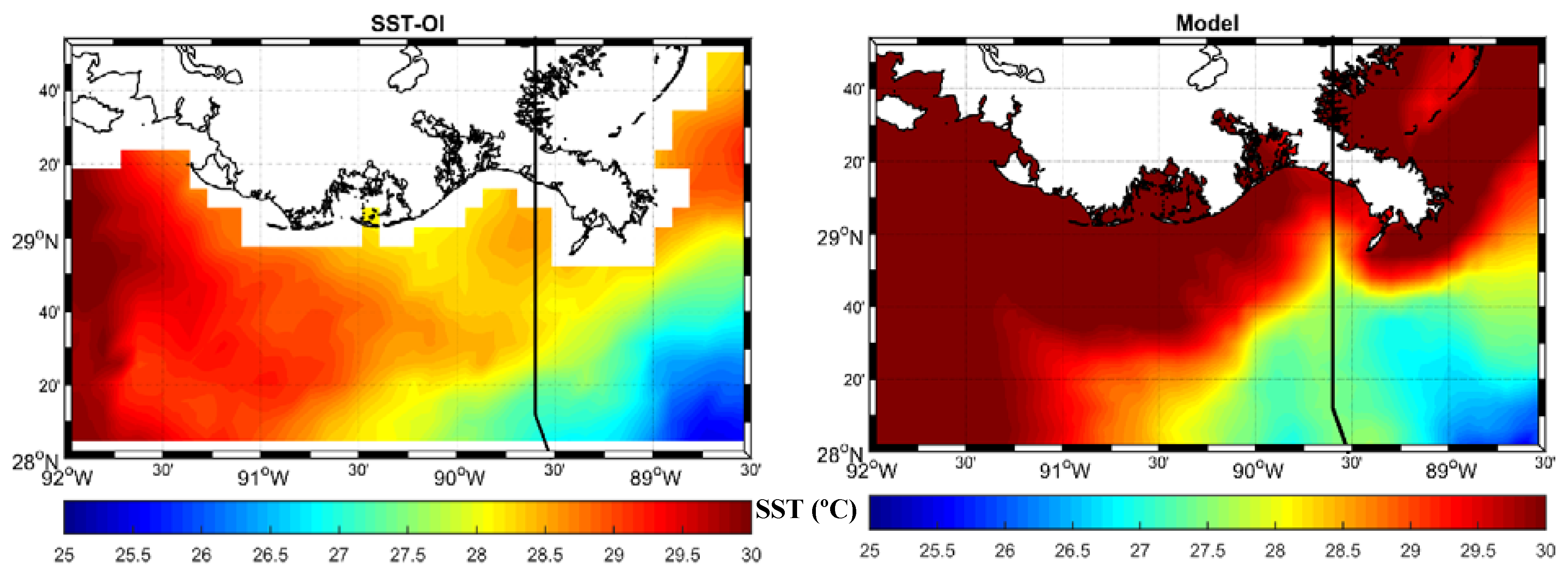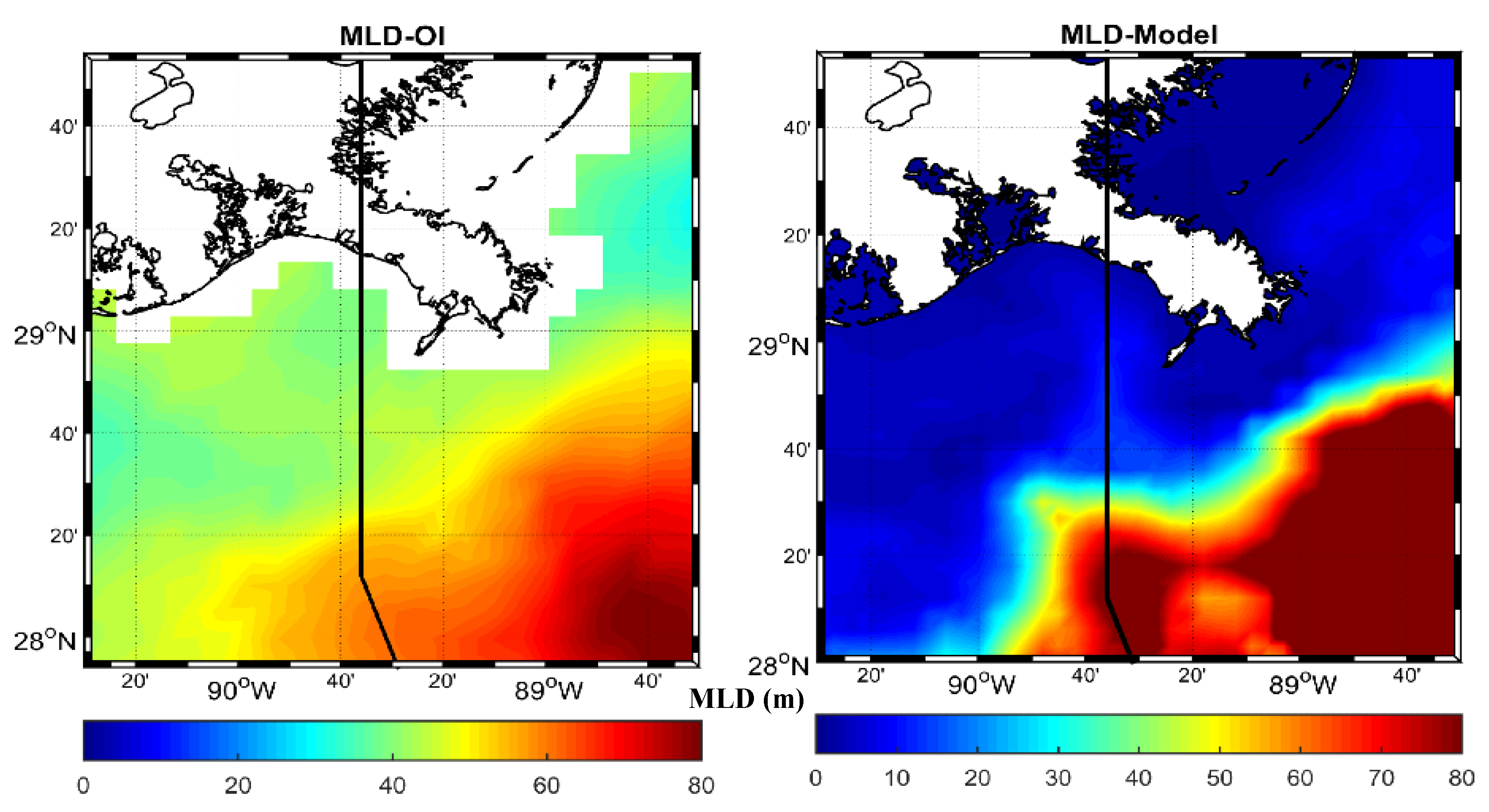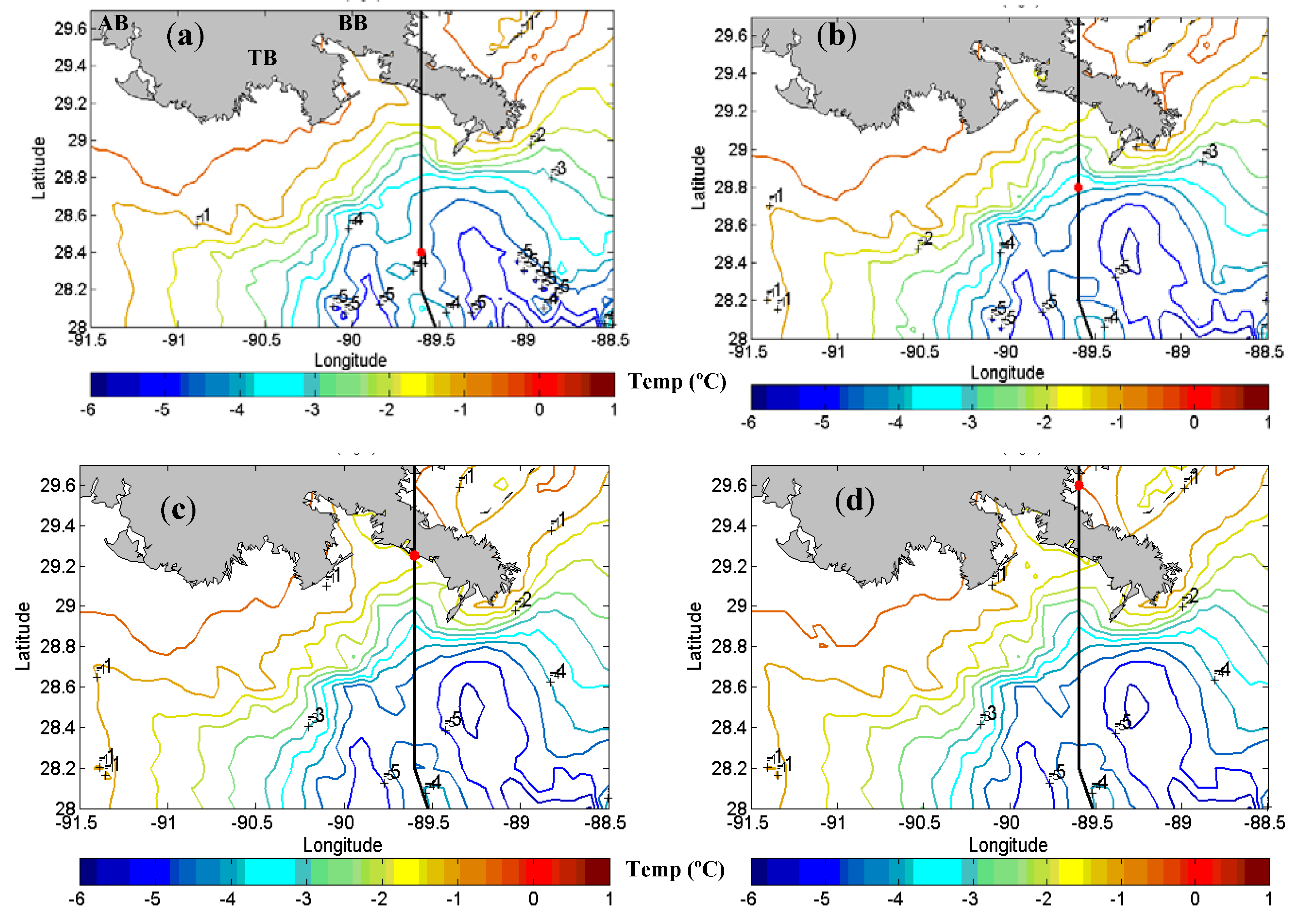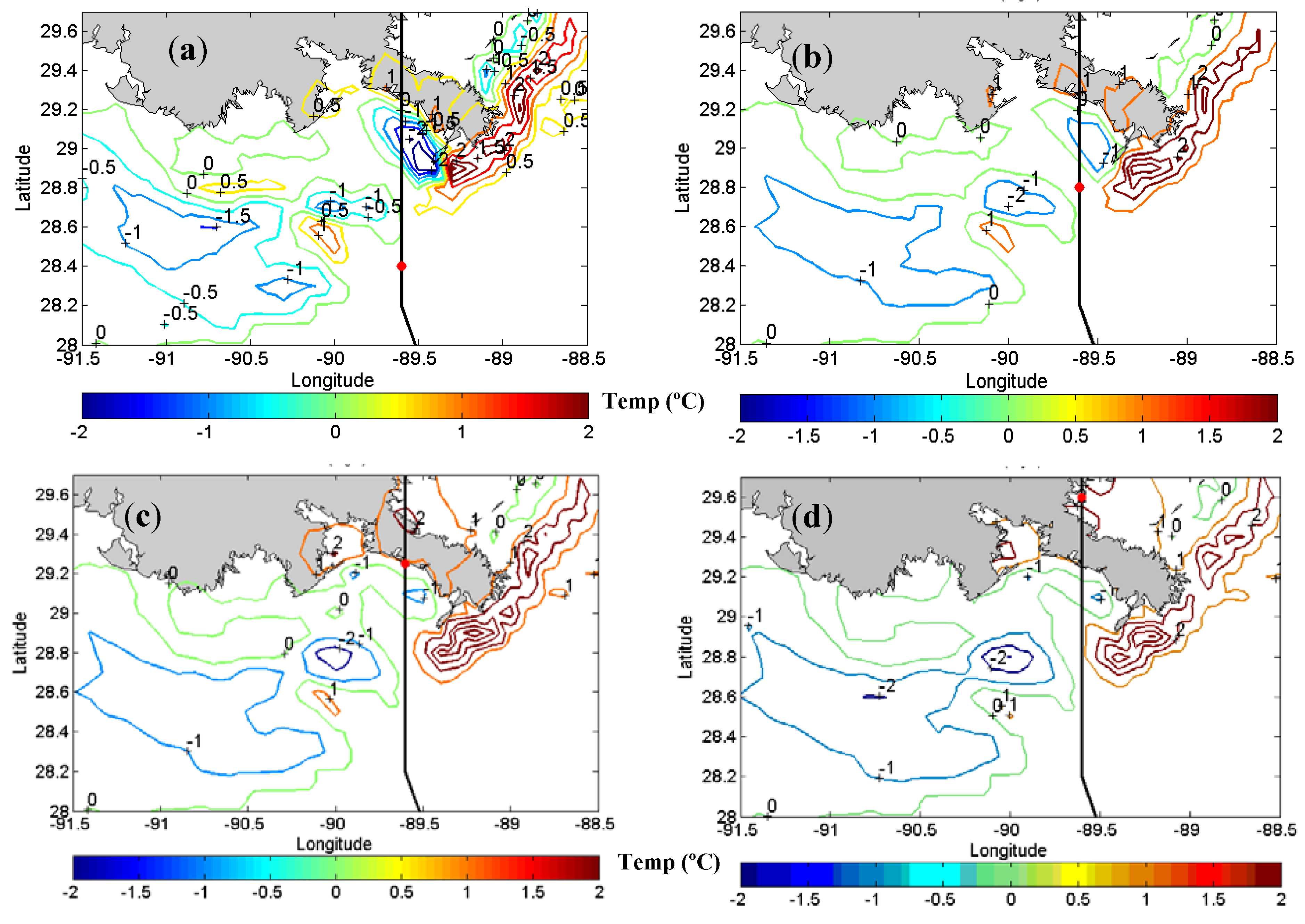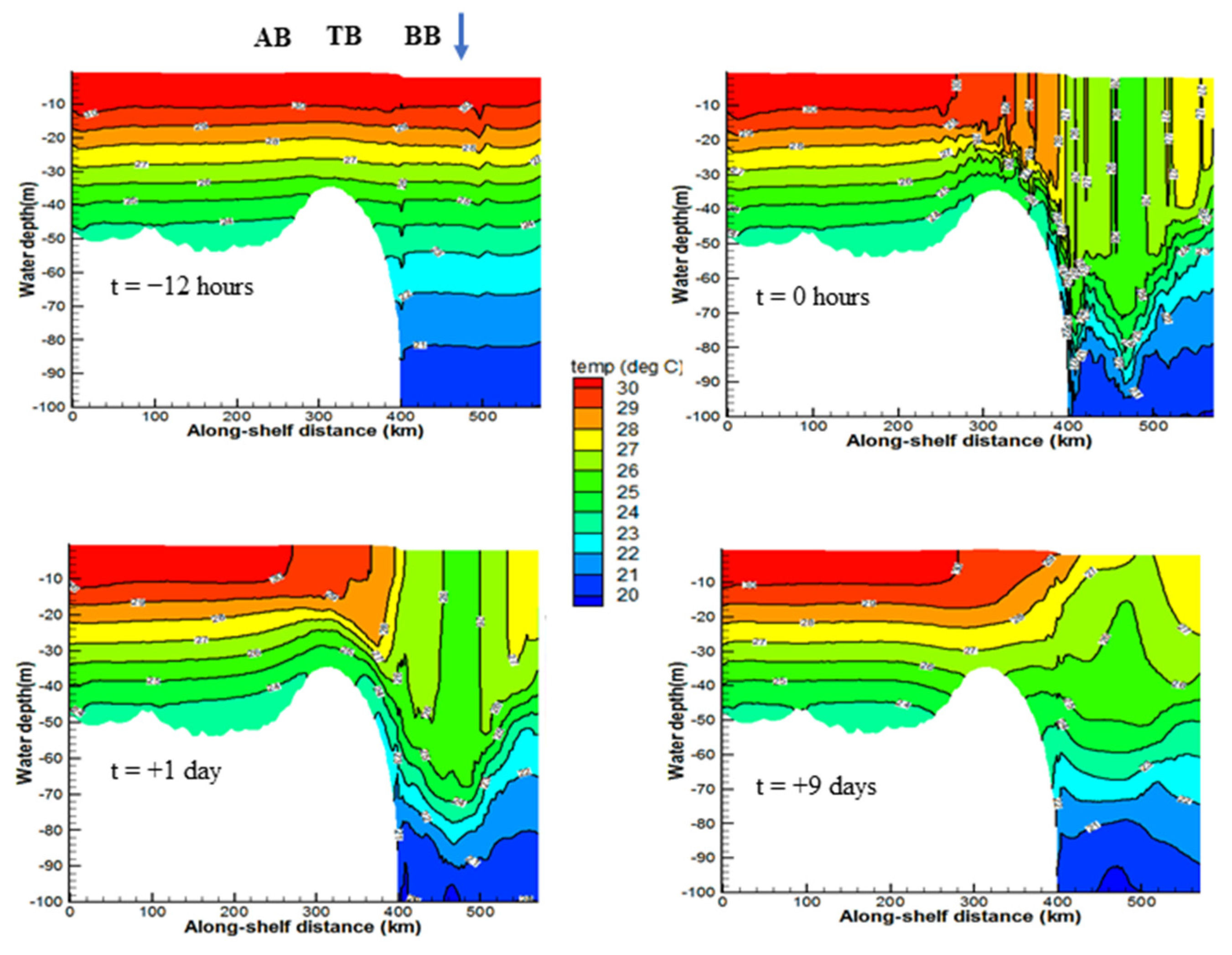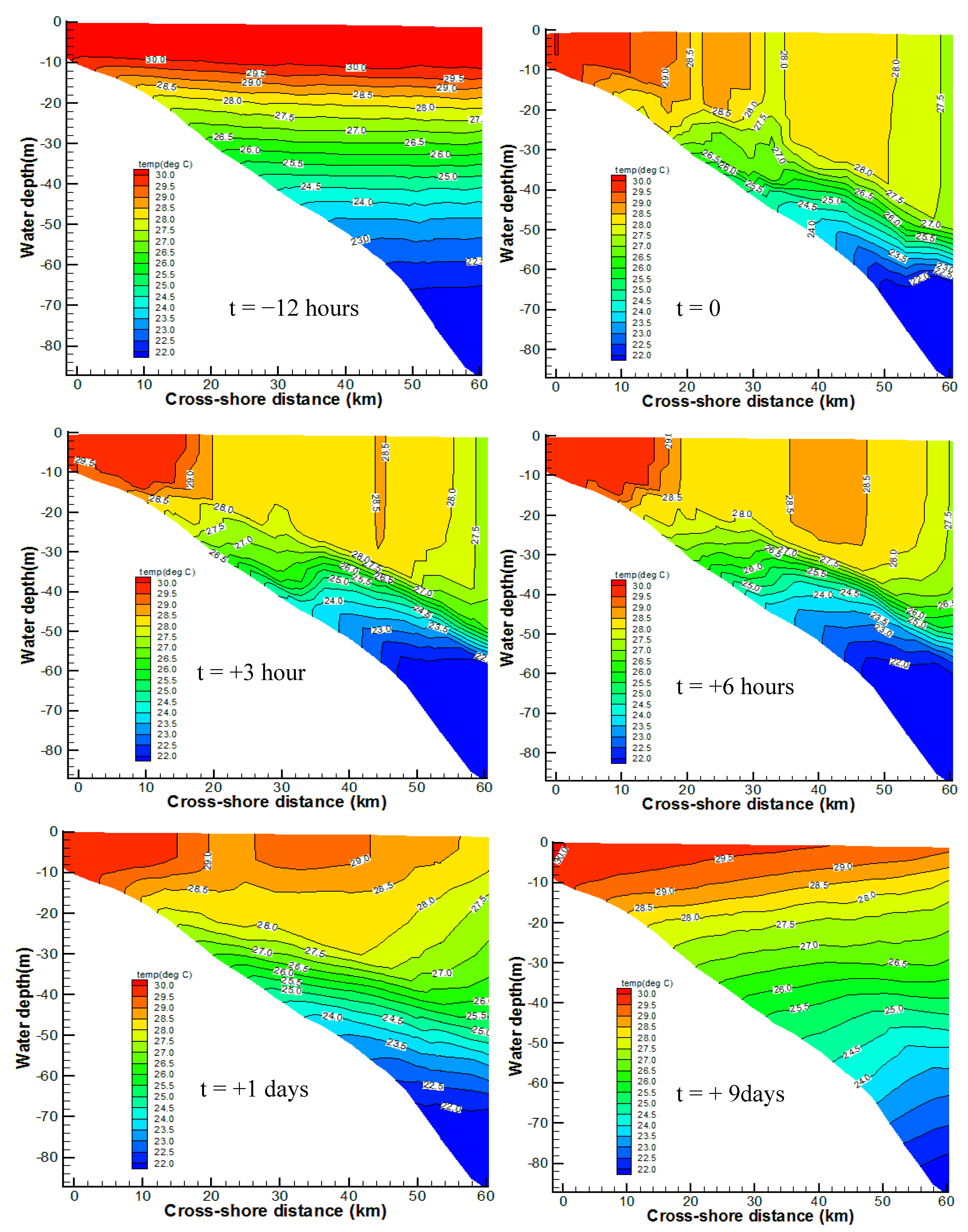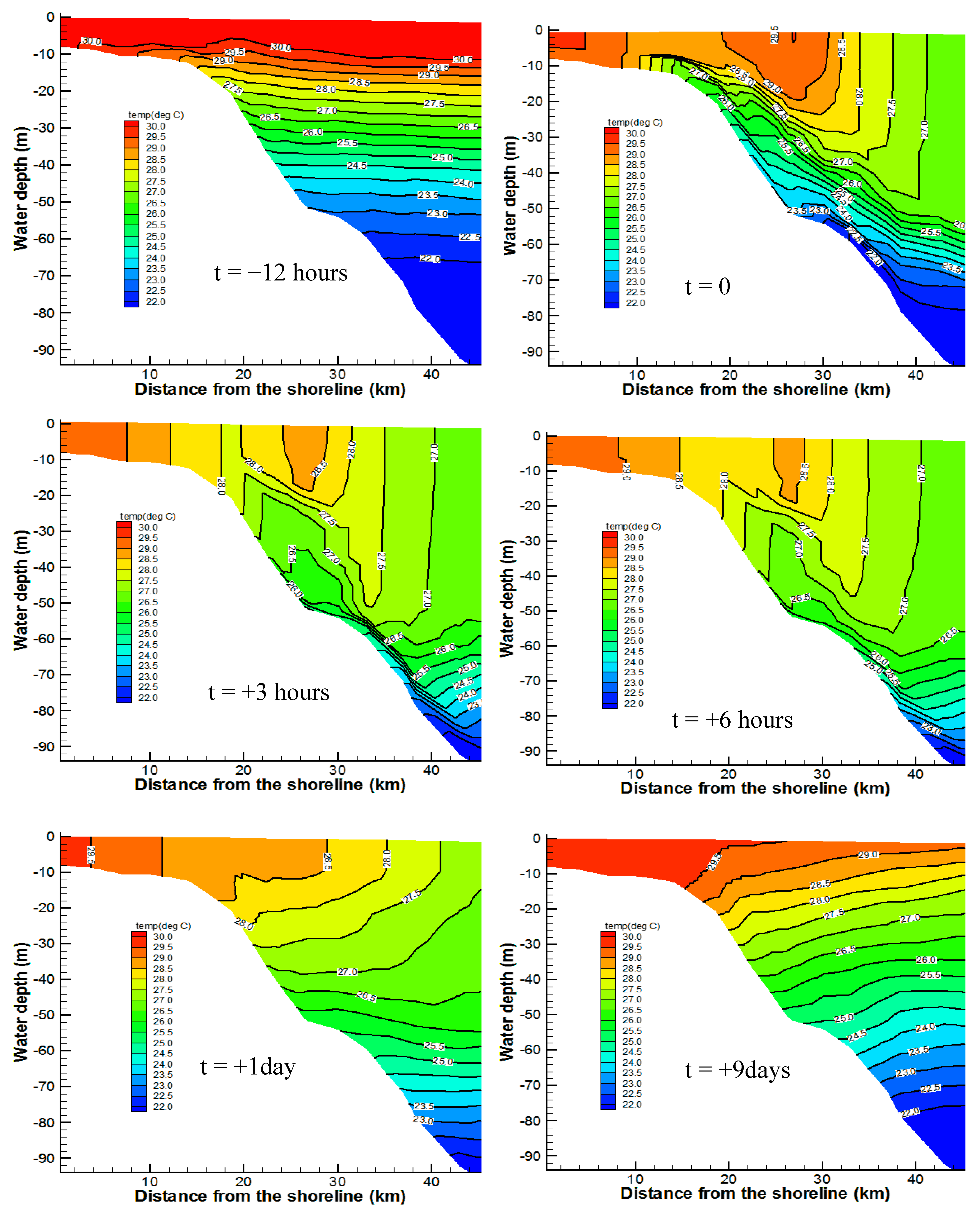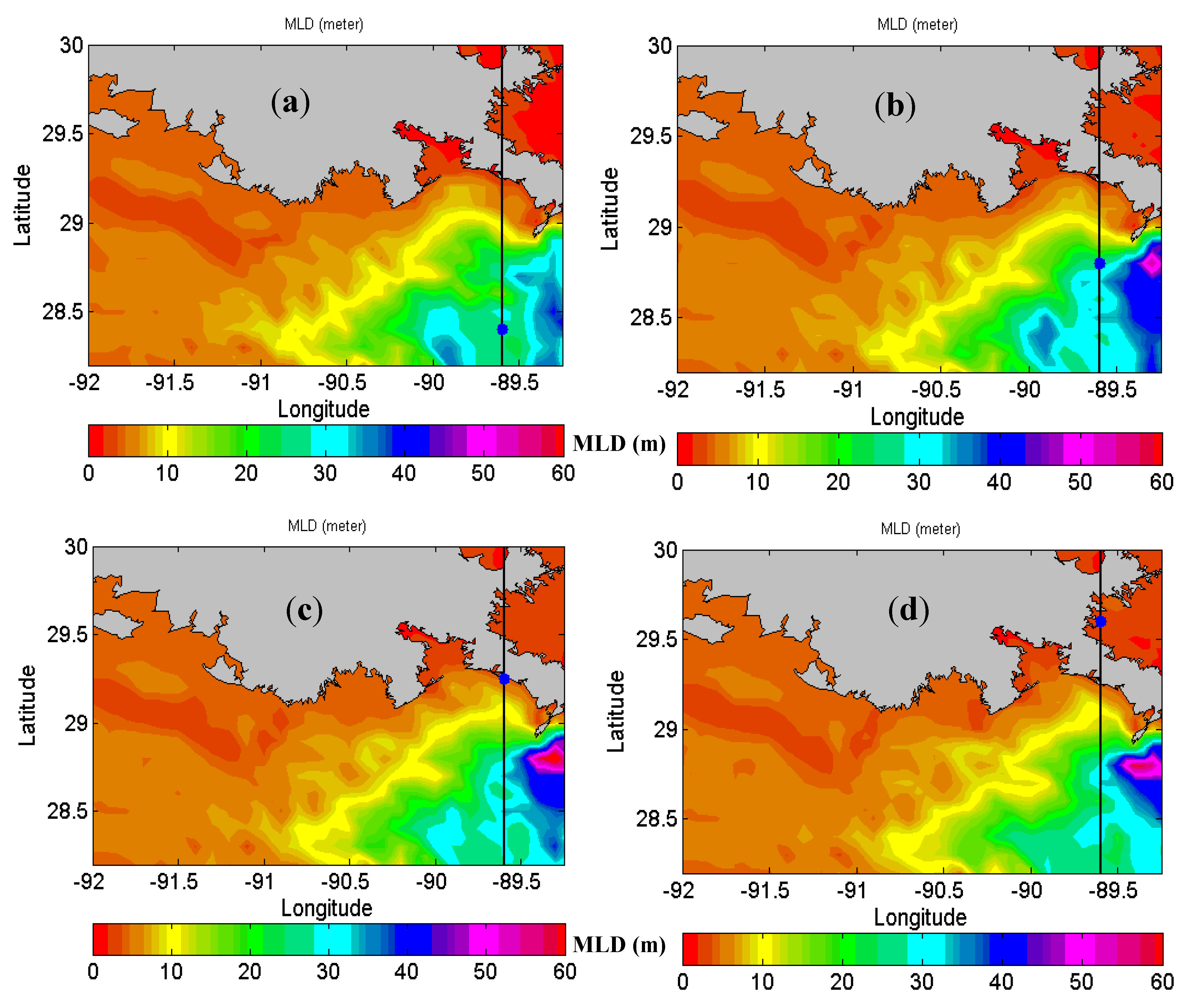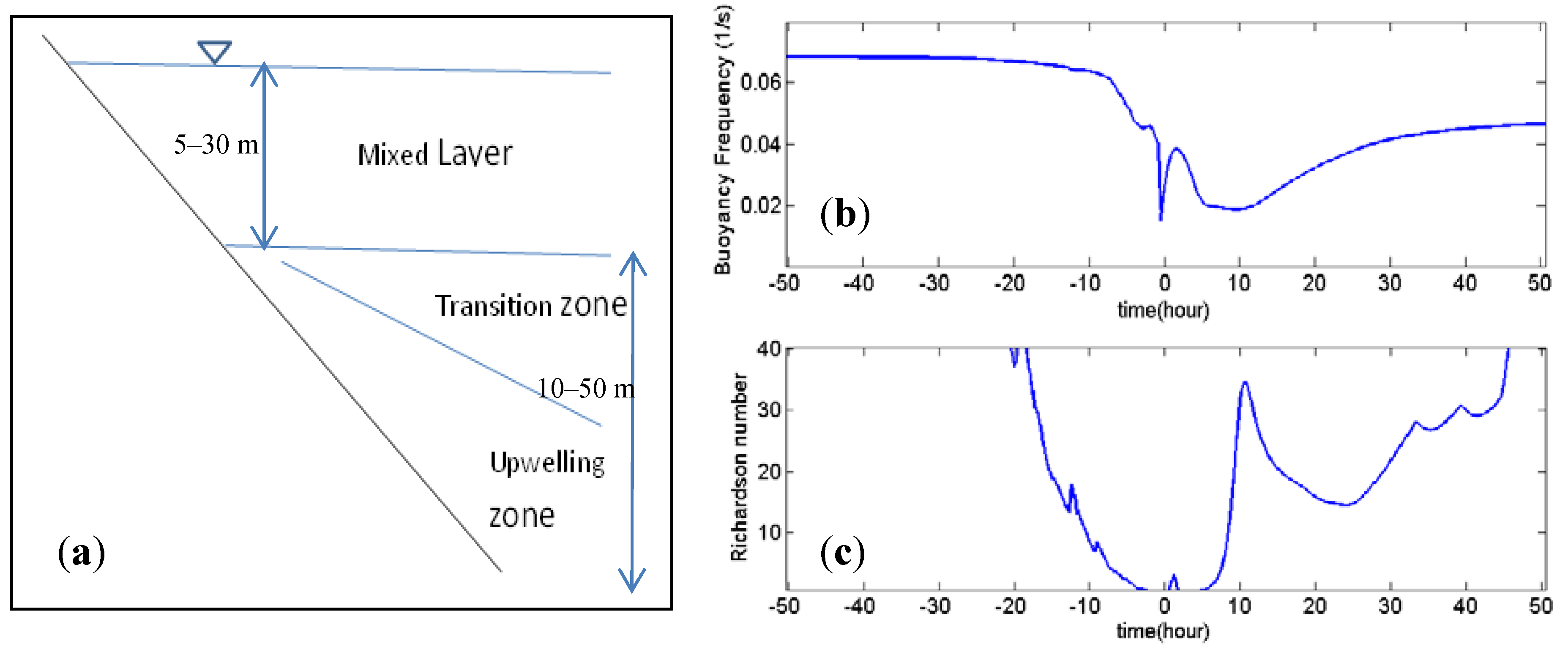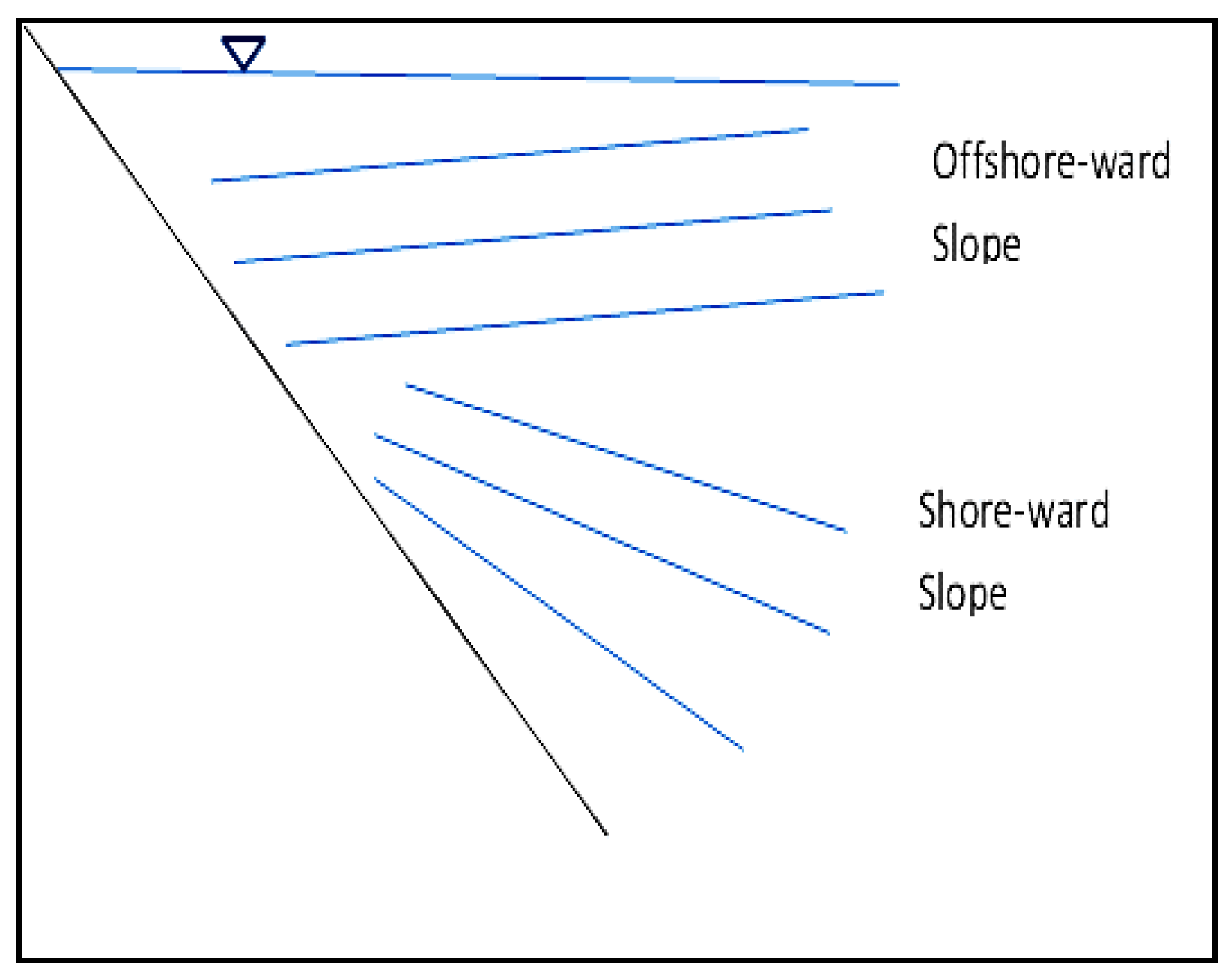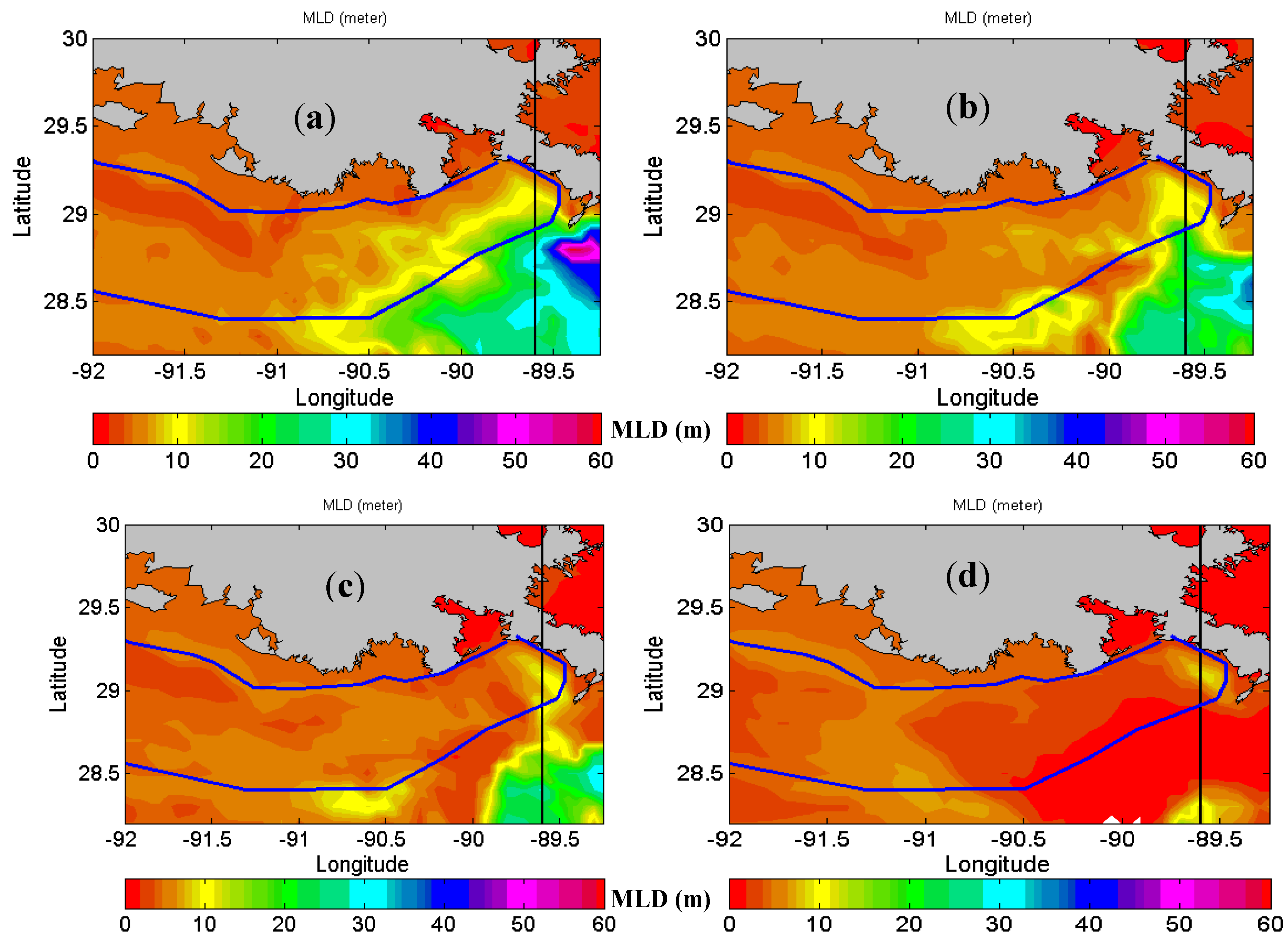1. Introduction
Tropical storms, including hurricanes, can cause ocean surface cooling, turbulent mixing, and inertial motions, as addressed in many studies in the last few decades. Field and satellite observations, as well as numerical models, have been extensively used to study the oceanic response and the mixing induced by tropical storms (e.g., [
1,
2,
3,
4,
5,
6,
7,
8]). Heat loss to the storm, entrainment by turbulent mixing, and advection all contribute to the mixed layer heat budget [
4]. Entrainment by turbulent mixing is the primary mechanism of the deepening of the mixed layer [
3,
4]. Within the radius of the maximum wind (RMW), the surface divergence caused by the cyclonic wind and the Ekman effect enhance upwelling and reduce the mixed layer depth (MLD). For most tropical cyclones, rightward bias causes the maximum MLD deepening and surface cooling to occur just beyond the radius of maximum wind on the right side of the track [
3,
9]. However, at any given time, the MLD decreases as the radial distance increases from 1 RMW, where surface convergence produces downwelling [
10].
In coastal and inner-shelf waters, even though the responses have some similarity to those in the deep water, bottom topography and coastal boundary can further modulate the SST and MLD responses [
11]. Near-inertial oscillations in the post-storm stage are mostly present in water depths larger than 70 m [
11]. Over the shelf regions with water depth ~50 m or less, oscillations are significantly damped as a result of bottom friction [
12]. Temperature and salinity variations in shallow water during hurricanes have been less studied, and yet they are important variables characterizing stratification. Several studies examined SST variations, and other shelf responses to hurricanes (e.g., [
13,
14,
15]). Spekhart [
14] (
https://libres.uncg.edu/ir/uncw/f/speckhartb2004-1.pdf, accessed on 28 June 2022) used field measurements of wind, current, temperature, and salinity to study the response of Onslow Bay, NC, to three consecutive hurricanes, namely Dennis, Floyd, and Irene, within a two-month period in the fall of 1999. Analysis showed that strong inertial oscillations associated with the hurricanes in deep waters were significantly damped in shallow water. The strong shear induced by Hurricane Dennis, lasting an extended amount of time, caused the sea surface temperature to drop by about 3 degrees, producing a completely mixed water column. Consequently, the water appeared as barotropic during the time while Dennis was translating along the coast, even at water deeper than 70 m. Modeling studies of mixing induced by hurricanes over shallow and estuarine waters are scant [
12,
16]. Li et al. [
16] applied a high-resolution ocean model ROMS coupled with the atmospheric model MM5 to simulate the temporal and spatial response of temperature and salinity in the Chesapeake Bay to Hurricane Isabel, which made its landfall southeast of the Bay in September 2003. Results showed that the pre-storm strong salinity stratification was completely destroyed, due to the hurricane-induced current shear and vertical turbulence. Hence, a complete mixing was dominant along the axis of the Bay, even at water depths as large as 25 m. The simulated temperature and salinity across the water column showed that the fully mixed state lasted for several hours after the peak of the hurricane. The stratification started to rebound several hours after the hurricane (reaching a significant stratification after one day), due to a large density gradient within the estuary.
The understanding of the detailed behavior of the temperature and salinity response of the shelf/estuarine waters to a hurricane still needs a significant amount of effort, especially the mixing pattern and the re-stratification timescale after the hurricane. Understanding water column mixing and post-storm stratification over the oceanic and shelf waters has several important implications in studying and simulating the circulation and dynamics of biogeochemical parameters. From a circulation viewpoint, a mixed water column can inhibit the wind or tide energy with the mixed layer amplifying surface currents that also affect the circulation pattern at other depths across the water column, while a pre-mixed water column can cause a very different circulation pattern, compared to a pre-stratified one [
17,
18]. Mixing the water column can substantially contribute to the transport of biogeochemical substances from the water surface to the euphoric zone and vice versa [
19]. One significant impact is redistributing the dissolved oxygen across the water column. This could cause re-oxygenation of depth waters in the regions with a low concentration of dissolved oxygen. This re-aeration is especially important for the Louisiana shelf in the northern Gulf of Mexico, which inhibits the world’s second-largest seasonal hypoxic zone [
20,
21]. Observations showed that passing a hurricane in the hypoxic times during the summertime can significantly re-oxygenate the hypoxic shelf waters in a span of days to weeks [
20]. Mixing deep, cold, nutrient-rich waters with warmer surface waters as a result of both turbulent mixing and upwelling can substantially enhance biological activities across the water column, including phytoplankton blooms that are essential components of biogeochemical processes in the ocean that affect the oceanic food web [
19,
22]. Compared to a region with a mixed water column, a stratified shelf/oceanic region with high heat content can significantly enhance the hurricanes and upgrade their intensity, since the upper ocean actively interacts with hurricanes and provides the heat energy for the formation and intensifies them [
2,
3].
Among all the physical aspects of mixing induced by a hurricane, the direct contribution of hurricane wind and entrainment by turbulence in the process are of particular interest. Therefore, the 3D dynamics of the response within an appropriate timescale need to be fully investigated. The present study attempts to provide such a high-resolution model by simulating the response of the stratified Louisiana shelf to Hurricane Katrina. The major focus of this modeling study is understanding the direct role of entrainment by turbulent mixing on SST cooling and deepening of the mixed layer. High spatial and temporal resolution results for water temperature across the water column and over the modeling area are used to examine shelf response to the turbulent mixing entrainment caused by Katrina. The examined results include maps of SST and bottom temperature at different times during and after Katrina, the timeseries of water temperature across the depth at different locations, shelf-wide water temperature, and cross-shelf water temperature at different transects. These outputs were used to deduce the patterns of shelf mixing and re-stratification during and after passing the hurricane. To our knowledge, this study provides new results and enhances the understanding of mechanisms of shelf mixing and re-stratification during and after a hurricane. Although a fully baroclinic model, including both heat and salt equations, has been used, the focus of this study is to study the response of water temperature to the hurricane, and the model verification has only been done using the temperature data. Hence, only the results for temperature response at the surface and across the water column are presented.
2. Study Area/Hurricane Katrina
The study area of this paper is the Louisiana continental shelf in the northern Gulf of Mexico (
Figure 1). The response of this relatively shallow shelf to hurricanes can be affected by bathymetry and coastal geometry. Weak wind stress and low energy waves in the summer (Mid-June to Mid-September), along with intense solar insulation, produce a stratified layer over the shelf during this season [
23,
24]. This stratified layer that can significantly contribute to the bottom water hypoxia [
25] may be broken down by the occasional passes of tropical storms/hurricanes formed and passing over the shelf, mostly from August to October [
26]. Hurricane Katrina was one of the most disastrous hurricanes in U.S. history with respect to its damages and impacted both the east and west of the Mississippi birds foot delta. Hurricanes Andrew (1992), Ivan (2004), Gustave (2009), and Ike (2009) are other examples of devastating hurricanes that caused substantial damage and fatalities in the northern Gulf of Mexico and Louisiana shelf. Starting as a tropical depression over the Bahamas on 23 August 2005 [
27], Katrina reached a category 5 Hurricane on 28 August after passing over the warm waters associated with the Loop Current [
28]. The hurricane degraded to some extent as it approached the Louisiana shelf. In the early morning (UTC) on 29 August, as a category 3 hurricane, it made its first landfall between the Grand Isle, LA, and the Mississippi River mouth.
Figure 1 shows the track of Hurricane Katrina as it traveled in the northern Gulf of Mexico.
4. Model Results
The numerical model experiments were done using the turbulence parameters obtained in 3.3. The model runs included about ten pre-storm days and ten days after the hurricane landed (a total of 20 days). This section discusses the distributions of temperature affected by the hurricane.
4.1. Sea Surface and Bottom Temperature from the Simulations
Figure 8 shows the calculated cooling induced by Hurricane Katrina over the inner and outer shelves at different times based on simulation results. The time origin for these in
Figure 8 and also
Figure 9 is the landfall time over the birds foot delta (landfall time is zero). Hence, all times before the landfall are negative and times after the landfall are positive. About 4 h before landfall over the birds foot delta (hour −4), the eye was located almost 80 km southwest of the birds foot delta (
Figure 8a); the category four hurricane produced substantial amounts of cooling over the outer shelf. Surface cooling as large as 6 °C occurred along the track, with significantly larger cooling areas on the right side of the track. At the edge of the shelf break off the Barataria Bay and the Terrebonne Bay, the cooling was 3 °C and 2 °C, respectively. The surface cooling decreased landward and stopped at the mouth of the Terrebonne and the Atchafalaya Bay. Two hours later, when the eye was 25 km southwest of the Southwest Pass (
Figure 8b), the maximum surface cooling was 1 °C. The distribution of surface cooling over the inner-shelf was similar. At landfall, the inner-shelf area on both sides of the track experienced surface cooling of 2–2.5 °C, while at the mouth of Barataria Bay and off the Terrebonne Bay, there was about a 1 °C warming (
Figure 8c). The near-bottom water cooling along the lowest sigma level is shown in
Figure 9. Over the inner shelf, the lowest sigma level represents the bottom water, while over the deep waters, the associated depths were generally larger than 100 m. At hour −4, the bottom water at the edge of shelf-break off the Barataria Bay had a warming of about 0.5–1 °C. There was bottom warming for the shelf-break area off the Terrebonne Bay of 1–1.5 °C. The bottom warming over this area was likely due to less surface mixing and a lower rate of warm surface water entrainment down the water column. Over the inner-shelf on the left of the track, the bottom water temperature was almost unchanged, while on the right side of the track, the decrease in bottom water temperate was 1 to 2 °C, apparently due to the hurricane-induced upwelling. Two hours later, when the eye was almost over the shelf break at the west of the birds foot delta, there was a warming over the shelf break off the Barataria Bay of about 1–2 °C. The bottom temperature over the inner shelf on the left side of the track was still unchanged. At landfall, for the next two hours, the birds foot delta area experienced the maximum warming of 1 °C over the shelf off the Terrebonne and Atchafalaya Bays, most likely due to the downwelling caused by the northwesterly/westerly hurricane winds over these areas.
4.2. Time Series of Water Temperature
To further evaluate the evolution of the hurricane-induced temperature mixing across the water column over the Louisiana shelf, the time series of vertical water temperature variations are examined at several points on both sides of the hurricane’s track (
Figure 10).
For each point, the temperature variations were investigated for 50 h before and 50 h after the time that the hurricane’s eye was right at the west of the Southwest Pass (hereafter called CP time). Hence, positive time is after the eye passed this location, while negative time is before the eye was at these locations. The timeseries’ are examined in all locations, but for the sake of brevity, only the details at P3, P4, P5, and P5 that are on the left and the right side of Katrina’s track (almost within 1 RMW) are presented (
Figure 11) For each station, the upper panel timeseries show SST, while the colored contours show the vertical variations of water temperature with time). Stations P1 and P2 are far from 1 RMW, and the effect of hurricane wind on their SST and MLD are not as significant as others. Station P7 is located on the hurricane track, and its SST and MLD are affected mainly by upwelling and with less contribution by the wind-induced turbulent mixing.
Station P3 is located off the Terrebonne Bay at a water depth of 33 m about 40 km west of the hurricane’s track (left side). At hour −3, the SST dropped to about 28.6 °C, with about 2.4 °C surface cooling. This minimum was followed by a peak of 30.2°C, caused by the advection of warm water. In 10 h, turbulent mixing decreased the SST to 29.4 °C, but after the hurricane’s landfall, the SST began the relaxation phase and increased to a stable value of 29.8 °C at hour 50. The initial stratification was affected by the hurricane winds starting several hours before the CP time. An ephemeral mixed layer with a depth of 15 m and a temperature of 30.2 °C at CP time was present. During the next several hours, the MLD and temperature decreased to 12 m and 29.4 °C, respectively; and 5 m and 29.8 °C, respectively, during the relaxation phase (the post-storm time). The lower level water temperature (below ~20 m) was affected by upwelling. The coastal upwelling over the Louisiana shelf on the left side of Katrina’s eye was produced by the westerly to southwesterly hurricane winds (
Figure 3). These winds were at about the landfall and beyond. Station P4 (left side of the track), with a water depth of ~30 m, was closer to the mouth of Barataria Bay and was located northeast of P3. The distance from the hurricane’s track was 25 km (note that for Katrina, the radius of maximum wind was 30–35 km over the Louisiana shelf). Hence, a more significant effect of turbulence mixing was expected at this station. SST at this location decreased almost linearly from 30.5 °C at hour −10 to 27.8 °C at hour 5. The SST rebound started after the landfall and increased to 29.6 °C at hour 50. At about hour −10, the shear entrainment mixed the surface warm water with bottom cold water down to 25 m. This significant mixing event produced a mixed layer depth of about 20 m and a temperature of about 28 °C at hour 3. The mixed layer stayed almost the same for several hours until the relaxation phase started at hour 10 when the water column started to warm again. During this period, the MLD decreased from 20 m at hour 5 to a stable value of 5 m at hour 50. The upwelling was less intense than other stations west of the track because of the closer proximity of P4 to the coastline.
The effect of Hurricane Katrina on vertical mixing on the right side of the track was investigated by examining the time series of SST and vertical temperature structures at stations P5 and P6. It is found that the shelf response on the right side is highly affected by the geometry of the birds foot delta with the rightward bias caused by the asymmetric wind of a moving hurricane. Station P5 was located northwest of the South Pass, where the water depth was about 11 m, and the distance from the hurricane’s track was about 10 km. The simulated SST at this location shows that the SST decreased from about 30.5 °C at hour −10 to 28.8 °C at hour 0, indicating 2 °C of surface cooling from the initial SST of 30.8 °C. After the hurricane passed the station, SST began to increase and reached 29.3 °C in 24 h. Afterward, the SST continued increasing at a slower rate and reached 29.5 °C at hour 50. The hurricane’s effect on the stratification at this station started at about hour −22. A change from the initial stratification started to be visible at this time. After about 24 h (at hour 2), the water column was fully mixed to about 29 °C. This was about 1 C lower than the initial water temperature at the bottom. It indicates the effect of cold water upwelling and advection from the deeper shelf areas in the south. This station remained fully mixed for the next 50 h, and the temperature increased to about 29.4 °C. Since station P5 is located within 1 RMW, its temperature was highly affected by the hurricane-induced upwelling. Station P6 was also on the right side of Katrina’s track. It was located south of the South Pass at 30 m water and was about 10 km from the track. Katrina caused 2.5 °C surface cooling at this station. The main part of the cooling started from hour −20, when the SST was about 30.5 °C. The SST decreased to about 28.5 °C at hour 10 and remained the same for the next 40 h before it started a gentle increase. The initial stratification at this station was disturbed primarily by the upwelling at about hour −10. This caused an increase of 2.5 °C in water temperature at about 25 m. Due to the station’s proximity to the outer shelf and deep waters, the recovery of water column temperature after the hurricane’s landfall was relatively slow, as illustrated by the vertical structure at hour 50.
To better understand the mixing and stratification timescale, a longer time series (15 days) of SST and vertical temperature structure are examined for P4 and P6 (not shown). At P4, SST and stratification became stable at hour 50 and exhibited consistent patterns for temperature and the MLD values over time. At this time, the SST was 1.2 °C lower than the pre-storm SST. The post-landfall temperature response at station P6 was similar to P4. However, as mentioned before, it took a longer time (longer than 50 h after the landfall) for both SST and stratification to reach a stable condition (almost constant water temperature and MLD over time). The SST on the 9th day after the landfall was still 1.5 °C lower than the initial value. Longer model results showed that this stable condition continued for at least two weeks after the landfall.
4.3. Shelf-Wide and Cross-Shelf Distribution of Temperature across the Water Column
We also examined the vertical structures of water temperature across two north–south (cross-shelf) and east–west (along-shelf) cross-sections.
Figure 1 shows the locations of east–west section 1 and north–south cross-sections A and B.
The east–west section 1 crossed the latitude of 28.8, which is roughly corresponding to the shelf break. The eye passed over this section at 6:00 (UTC) on 29 August 2005. For this section, temperature variations were examined with respect to the time that the eye crossed the section (
Figure 12). At hour −12, the initial stratification was almost intact, while at hour zero, intense mixing was produced under the eye and on the right of the track. The maximum MLD was ~65 m with a water temperature of 25 °C and was observed at about 40 km from the eye, which was about 1 RMW. Under the eye, the MLD was about 50 m as a result of smaller turbulence mixing and the hurricane-induced upwelling. The amplitude of oscillations produced at the base of the mixed layer and the right side of the track was about 10 m. These oscillations dissipated when they hit bottom and produced a complex pattern of temperature variations across the lower water column off the Barataria and the Terrebonne Bays (
Figure 11, hour 0). The MLD and mixed layer temperature, produced due to the turbulence mixing, was about 35 m and 28 °C, respectively, off the Barataria Bay. These values changed almost linearly to about 20 m and 30 °C, respectively, off the Terrebonne Bay. No significant mixing was produced west of this area along section 1. The main feature of the temperature structure across this section at hour 3 was the formation of distinct mixing zones with different temperatures as functions of the distance from where the eye crossed the section. A zone of maximum mixing similar to time zero was present at 40–80 km on the right side of the eye. Another zone of substantial mixing with smaller MLD (about 50 m) was under the eye’s location and a third one on the right side of the maximum MLD. The mixing region over the shelf west of the track can also be divided into different zones, with decreasing MLD westward. These temperatures and patterns lasted until at least hour 6. Eighteen hours later (+1 day), the stratification in the shelf water west of Barataria Bay and off Terrebonne and Barataria Bays almost started to recover. The pattern stayed the same for mixed zones on the right of the track with slightly reduced MLD. A completely stratified water column off the Barataria Bay was the most distinct feature of temperature distribution at the beginning of day nine after the eye crossed the section.
Similar to the east–west section, the temperature response along the north–south transects is presented for six different times, i.e., hours −12, 0, 3, 6, 24 (+1 day), and +196 (or 9 days). Several transects over the Louisiana shelf were examined to reveal the mixing and re-stratification during and after Katrina. The mixing and re-stratification patterns for all sections were similar, and the differences were mostly regarding the intensity of mixing that varied depending on the distance from Katrina’s track. Here, the simulation results across two cross-sections, one on the left side of track (A) and one on the right side (B), which are described in detail. Temperature variations along these two transects and across the water column are shown in
Figure 13 and
Figure 14.
Transect A was selected at the distance of 20 km on the left of the hurricane’s track, in front of Barataria Bay. The initial stratification was broken at time zero when the maximum MLD was about 45 m at the offshore edge of the transect (
Figure 13). This substantial mixing was due to the intense hurricane wind within the 1 RMW. The MLD decreased linearly to about 10 m at 15 m water depth, while the mixed layer temperature decreased from 27.5 °C at the offshore edge to about 29.5 °C at a depth of 15 m. At depths greater than 50 m, the upwelling was pronounced. There was an intense temperature gradient between the surface mixed layer and the bottom upwelled water. As the eye reached the latitude of the upper transect (at hour +3), the mixed layer temperature along the transect was already uniform. At hour +6, the maximum MLD decreased to about 35 m, and the upwelled water started to decrease the MLD at the mid-shelf. At +1 day, the surface water was still mixed with an MLD of about 10 m. At depths greater than 25 m, the upwelling started to recede, but the isotherms were still inclined shoreward. Isotherms between 15 m and 30 m showed shoreward and offshore-ward slopes, respectively. It suggests the combined effect of baroclinic and barotropic features on water column temperature.
Transect B was on the west of the Southwest Pass and 10 km of the right side of the track. At this location, a remarkable effect of the hurricane wind on stratification was seen. At time zero (
Figure 14), the MLD reached its maximum value of 55 m at the offshore end of the transect, where the total water depth was 90 m. Strong upwelling was produced under the mixed layer, transporting cold water to the coastal areas up to a depth of 10 m. At hour +3, turbulence mixing dominated the upwelling, and most parts of the transect were mixed. The MLD at this time varied from 60 m at the offshore end to 10 m at the onshore end of the transect. Due to intense vertical shear induced by the hurricane, the water column for a water depth smaller than 25 m was fully mixed. The mixed layer temperature varied between 26 °C and 29 °C. The fast deepening of the mixed layer interrupted the upwelling at a depth of 55 m. The pattern at hour +6 was similar to that at hour +3. Mixing was still dominant in the upper 12 m at the end of day +1 when stratification in waters deeper than 50 m was re-developed.
4.4. Mixed Layer Depth
Variations of the MLD over the inner and outer Louisiana shelves were calculated using the model results. A criterion for determining the mixed layer was applied following Montegut et al. [
34]. Based on this criterion, if the temperature difference was less than 0.2 °C, the water column was assumed to be mixed. The MLD maps are presented at four different times, at hours −4, −2, 0, and 2, where time 0 is the landfall time (
Figure 15). At hour −4, the maximum MLD over the deep water on the right side of the track was about 40 m. An extensive area with an MLD of about 20–25 m was observed on the left side of the track. The effect of the hurricane on the deepening of the mixed layer was pronounced off the Barataria Bay midway between the shelf break and the Bay’s mouth. The deepening extended to the west, off the Terrebonne Bay near the shelf-break, where the MLD was about 10 m. Over the rest of the inner-shelf, the MLD was about 5 m. At the time of landfall, more areas over the inner shelf east of the Atchafalaya Bay were affected by the MLD deepening. The deepening also occurred in front of Barataria Bay and west of the birds foot delta.
6. Summary and Suggestions
In this paper, the simulation of water column mixing and re-stratification over the Louisiana shelf during and after the passage of Hurricane Katrina was simulated using FVCOM, and the results were discussed by examining shelf-wide timeseries, maps, and transects of temperature and mixing depth. The initial temperature and salinity profiles were based on the climatological data for August from the WOA database. The climatological temperature profiles were modified using available SST data from AVHRR and measured temperatures at two different depths at a station located off the Terrebonne Bay. Satellite SST data from MW-OI products were used to evaluate the model SST and tuning two parameters used for calculating vertical eddy diffusivity. The MW-OI data were also used to estimate MLD based on an analytical approach and were successfully utilized to evaluate the simulated MLDs. The results were used to examine the temporal and spatial characteristics of mixing and re-stratification over the inner shelf. Since Katrina translated the inner shelf just west of the birds-foot delta, the mixing in most of the area between the shelf waters off the Barataria Bay and the birds foot delta was affected. The MLDs over this area were 10–30 m, while in the area west of Barataria Bay, the MLDs were 10 m or less. The hurricane-induced upwelling significantly affected the bottom temperature over the shelf from several hours before the hurricane reached the shelf to several days after. For the shelf areas on the east of Terrebonne Bay, the typical response of the water column was represented by a simple model, including a mixed upper water column, an upwelling-dominated lower water column, and a transition zone in the middle containing dissipating oscillations at the base of the mixed layer. The intense currents (up to 3 m/s) and vertical shears fully mixed the water column west of the birds foot delta and on the east side of the hurricane track. The main post-storm re-stratification mechanisms over the inner shelf were vertical density gradients, lateral density gradients, and offshore pressure gradients produced by upwelling across the shelf. Since the simulations did not include solar insulation, the upper water column stratification and the SST did not return to their respective initial conditions even 10 days after the landfall.
The comparison of the resulted MLDs during and after Katrina with the maximum probable hypoxic zone over the shelf showed that the mixing over the hypoxic zone west of the Terrebonne Bay could re-oxygenate the mid and bottom waters for several hours during Katrina. However, since the mixing was ephemeral and damped quickly after the landfall, the re-oxygenation appeared to be limited in time.
Compared to deep waters, the interaction of the atmospheric boundary layer and water column with the coastal geometry and the bottom boundary layer produces a more complicated response to a moving hurricane. The cooling induced by Katrina at the surface over the deep water followed the general pattern described before for the deep water. However, the surface cooling rate decreased toward the shelf break. At the shelf break, the cooling intensity substantially decreased; hence, even at the hour that the eye was hovering over the inner shelf, surface cooling was only significant in the vicinity of the track and over the other parts of the inner shelf, especially west of the Barataria Bay, the surface cooling was less than 1 °C. It suggests that the oscillations within the water column that contributed to deepening the mixed layer were dissipated when the mixed layer reached the bottom of the shelf break. Furthermore, the cross-shelf slope intensified the upwelling signal over the inner shelf, which can prevent mixed layer deepening. The birds foot delta highly affected currents and temperature response of the shelf waters confined between the delta and the hurricane’s track. Very strong currents and vertical shear were identified over this area. This produced a fully mixed water column and very small Richardson numbers during the time that Katrina was translating the inner shelf.
The results for the mixing pattern over the Louisiana shelf can be used for studying the effect of storms on the extent of the seasonal hypoxic zone over this region and quantifying the water column re-oxygenation either by using semi-empirical relationships or by incorporating the model setup from this study to a full biogeochemical model. This would be a topic for future relevant studies, regarding the efforts made during the last two decades to study the seasonal hypoxia in the northern Gulf of Mexico and predict its extension and intensity. The model setup with primary evaluation for the turbulent mixing parameters can also be used for studying phytoplankton bloom and other biogeochemical processes, as stated by McGee and He [
19].
Examining the effect of turbulent mixing parameters on temperature/salinity mixing is another aspect of this study that can enhance the knowledge about the parameterization of vertical turbulent closure and selecting the optimum parameters for simulating heat and salt transport. Although background eddy viscosity and the constant B1 for energy dissipation calculation are usually used as defaults in simulation, they could be site-specific or depend on the intensity of the forcing in the model.
